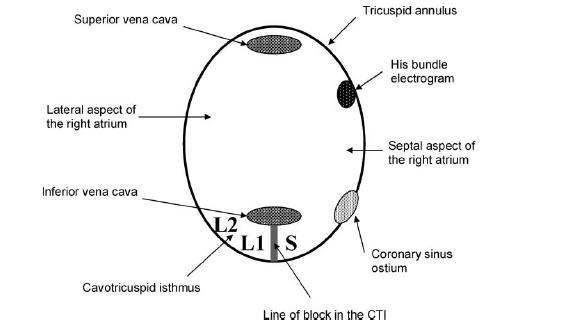Atrial flutter pathophysiology: Difference between revisions
| Line 4: | Line 4: | ||
==Overview== | ==Overview== | ||
[[Atrial flutter]] is a form of | [[Atrial flutter]] is a form of cardiac arrhythmia characterized by an atrial rate ranging from 240 to 400 beats per minute. It is one of the two types of atrial tachycardia, the other being [[atrial fibrillation]]. It is caused by a [[Cardiac arrhythmia#Reentry|reentrant rhythm]] in either the right or left atrium. Some degree of atrio-ventricular block is associated with atrial flutter. | ||
==Pathophysiology== | ==Pathophysiology== | ||
Revision as of 21:14, 5 January 2013
|
Atrial flutter Microchapters |
|
Diagnosis |
|---|
|
Treatment |
|
Case Studies |
|
Atrial flutter pathophysiology On the Web |
|
American Roentgen Ray Society Images of Atrial flutter pathophysiology |
|
Risk calculators and risk factors for Atrial flutter pathophysiology |
Editor-In-Chief: C. Michael Gibson, M.S., M.D. [1]; Associate Editor(s)-in-Chief: Cafer Zorkun, M.D., Ph.D. [2]
Overview
Atrial flutter is a form of cardiac arrhythmia characterized by an atrial rate ranging from 240 to 400 beats per minute. It is one of the two types of atrial tachycardia, the other being atrial fibrillation. It is caused by a reentrant rhythm in either the right or left atrium. Some degree of atrio-ventricular block is associated with atrial flutter.
Pathophysiology
Typically initiated by a premature electrical impulse arising in the atria, atrial flutter is propogated due to differences in refractory periods of atrial tissue. This creates a self perpetuating loop of electrical activity moving around the atrium.
The impact and symptoms of atrial flutter depend on the heart rate of the patient. Heart rate is a measure of the ventricular rather than atrial activity. Impulses from the atria are conducted to the ventricles through the atrio-ventricular node. Due primarily to its longer refractory period, the AV node exerts a protective effect on heart rate by blocking atrial impulses in excess of about 180 beats/minute (This block is dependent on the age of the patient, and can be calculated roughly by subtracting patient age from 220). If the flutter rate is 300/minute only half of these impulses will be conducted, giving a ventricular rate of 150/minute, ie. 2:1 block. The addition of rate-controlling drugs or conduction system disease can increase this block substantially (see image below).
